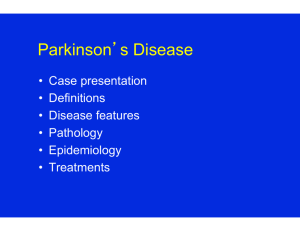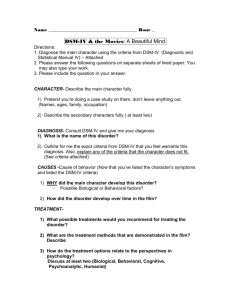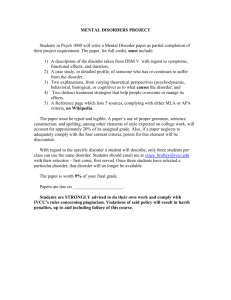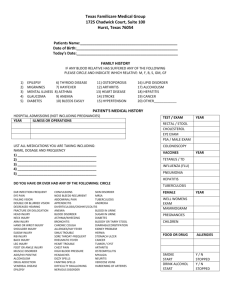0202_PD HD Clinical Lecture Spring 2016
advertisement
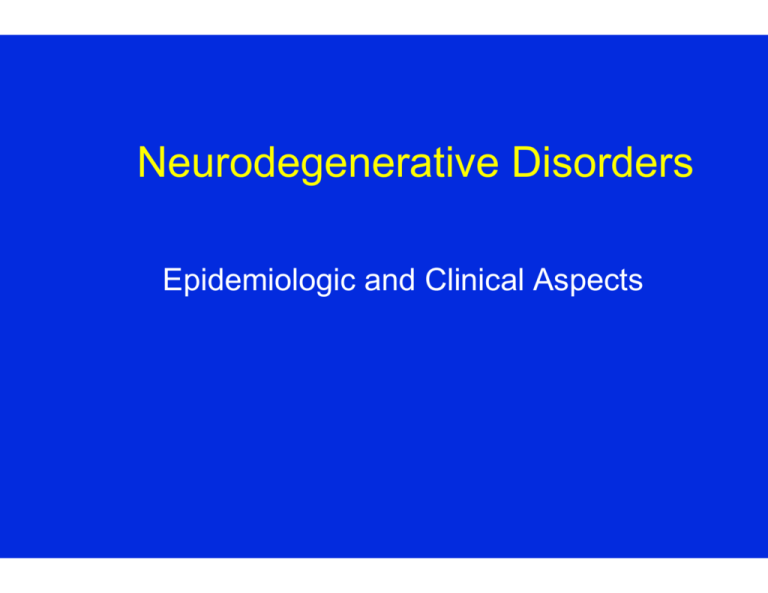
Neurodegenerative Disorders Epidemiologic and Clinical Aspects Pathway Structure Disorder A Disorder B Pathway Structure Risk Factors Disorder A Disorder B Pathway Structure Risk Factors Disorder A Disorder B Huntington’s Disease • Long Island, NY MD described disorder in 1872 • Estimated 30,000 Americans with HD • 10x regional variations in prevalence • Onset is usually between ages 30-45 although there is a juvenile variant • Progressive loss of functional ability and death in all patients within 10-30 yrs from onset Huntington’s Disease Movement disorder • Chorea -brief, semi-directed, irregular movements - not repetitive or rhythmic • Athetosis – writhing, twisting • Eye movement abnormalities occur early • Motor impersistence (inability to maintain position) • Dystonia (muscle contractions) and bradykinesia (slowed movement) – more prominent later in course of illness • Less common but can be seen – tics, tremor, myoclonus (rapid jerks) Choreo-athetosis HUNTINGTON’S DISEASE • Autosomal dominant neurodegenerative disorder • Determined by genetic mutation on short arm of chromosome 4 • Mutation is an expanded and unstable trinucleotide repeat of cytosine-adenosine-guanine (CAG); • < 35 No symptoms • 35–39 Variable expression • > 39 Essentially all become symptomatic • Mutation codes for abnormal polyglutamine expansion within the protein huntingtin • inclusion bodies of aggregated huntingtin found in HD brains Higher number of CAG repeats associated with earlier symptom onset Age at Onset HD is on one of 9 CAG repeat diseases that affect the nervous system Basal Ganglia Pathology in HD • Neuronal loss throughout cortex • Most prominent in striatum • Projections to Gpe particularly affected Functional Connections of Basal Ganglia How Does Caudate Pathology Cause Chorea? 1) Decreased Thalamic Inhibition via decreased indirect pathway activity a) Selective loss of indirect pathway striatal outputs b) Loss of inhibition of Gpe c) Increases GPe inhibition of STN and GPi/SNr d) Reduces excitatory STN output to Gpi & SNr e) SNr and GPi provide less inhibition of thalamus a b c c d Glutamate e GABA Neuroimaging Huntington’s Disease Co-morbid Symptoms • Cognitive impairment • loss of recent memory • poor judgment • impaired concentration • Occurs in nearly all patients • May precede onset of motor symptoms • Progresses to global dementia in later stages Huntington’s Disease Co-morbid Symptoms • Psychiatric impairment • Depression (10x suicide risk) • Personality changes • agitation, irritability, anxiety, apathy, social withdrawal, impulsiveness, mania, paranoia, delusions, hostility, hallucinations, psychosis, and sexual disorders • May precede onset of motor symptoms PARKINSONISM (‘pill-rolling’) (slowed movement) (‘lead-pipe’ or ‘cog-wheel’) Parkinsonian Syndromes • Idiopathic • Parkinson’s Disease • Atypical Parkinsonism • Symptomatic • Post-infectious (‘Awakenings’) • Toxic (MPTP, Manganese, CO) • Post-traumatic (boxers) • Drug-induced (neuroleptics) Cassius Clay/Muhammad Ali 3-time World Heavyweight Boxing Champion NBC Today Show Interview (1991) After Emergence of Post-traumatic Parkinsonism Parkinson’s Disease • 1817 - ‘Essay on the Shaking Palsy’ by James Parksinson • 1919 –selective loss of dopamine containing SN neurons in PD patients identified • 1960 – dopamine deficiency discovered in striatum of PD patients • 1961 – akinesia improves in PD and post-encephalitic patients with injection of levodopa, dopamine precursor • 1967 - levodopa becomes available in pill form Lewy body Deposition of a-synuclein PD reflects Selective Dopamine Insufficiency How Does DA Deficit Cause PD Motor Symptoms? 1) Increased Thalamic Inhibition via imbalance of Direct and Indirect Pathways a) Direct - Less D1-mediated inhibition of GPi & SNr b) Indirect i) More D2-mediated striatal inhibition of GPe ii) Less GPe inhibition of STN, GPi & SNr iii) More STN excitation of GPi & SNr b) i. a b) ii b) iii 1 EPIDEMIOLOGY Parkinson’s Disease • Peak age at onset = 60 • 2% lifetime risk, 4% if affected relative • 850K in US • M:F = 3:2 • Highest rate in Hispanics, lowest in African Americans • Can live 20+ yrs with treatment Incidence by Period Olmstead Co., MN GENETIC FACTORS IN PD • Twin Studies • Similar MZ – DZ concordance in 193 twin pairs • In 16 twin pairs with early PD (< age 50), concordance was 4/4 MZ pairs & 2/12 DZ pairs, suggesting strong genetic contribution to early onset cases • Family Studies • Southern Italian family • 50/592 with highly penetrant, autosomal-dominant, autopsyproven PD • Linkage analysis identified mutation on chromosome 4 at the SCNA gene that codes for alpha-synuclein • Subsequent linkage studies in large pedigrees have identified 24 other autosomal genes associated with PD ENVIRONMENTAL RISK FACTORS • Case-control studies show increased risk of PD with exposure to: • Herbicides, Pesticides • Living in a rural environment • Consumption of well water • Proximity to industrial plants or quarries • Smoking/caffeine associated with lower risk MPTP Model of PD • Parkinsonism seen in drug addicts exposed to synthetic heroin (MPTP) • Progressed over several weeks and improved modestly with dopamine replacement therapy • No other neuronal involvement (‘pure parkinsonism’) • MPTP in primates induces parkinsonism and selective degeneration of nigro-striatal DA neurons • Toxic to mitochondria • Chemical resemblance to some herbicides and pesticides suggests possible toxic etiology of PD via oxidative stress/other mechanisms PARKINSON’S DISEASE Non-Motor Features • • • • • Cognitive Dysfunction Depression Hallucinations (late) Autonomic dysfunction Personality change • restricted vs. compulsive behavior Parkinson-Plus Syndromes (α-synucleinopathies) Syndrome Location of Deposits Additional Symptoms Parkinson’s Disease (PD) Substantia Nigra (SN) neurons n/a Dementia with Lewy Bodies (DLB) SN & Neo-Cortex neurons Non-amnestic cognitive deficits, hallucinations, delusions Multisystem Atrophy (MSA) Depositions in Glia Poor response to levodopa Striatonigral Degeneration (MSA-P) SN mainly Olivopontocerebellar Atrophy (MSA-C) SN, Brain stem nuclei & Cerebellum Shy-Drager Syndrome (MSA-A) SN & Brain Stem Nuclei Genitourinary, orthostatic hypotension Ataxia, genitourinary, orthostatic hypotension Genitourinary, orthostatic hypotension Reduced Serotonin in PD
